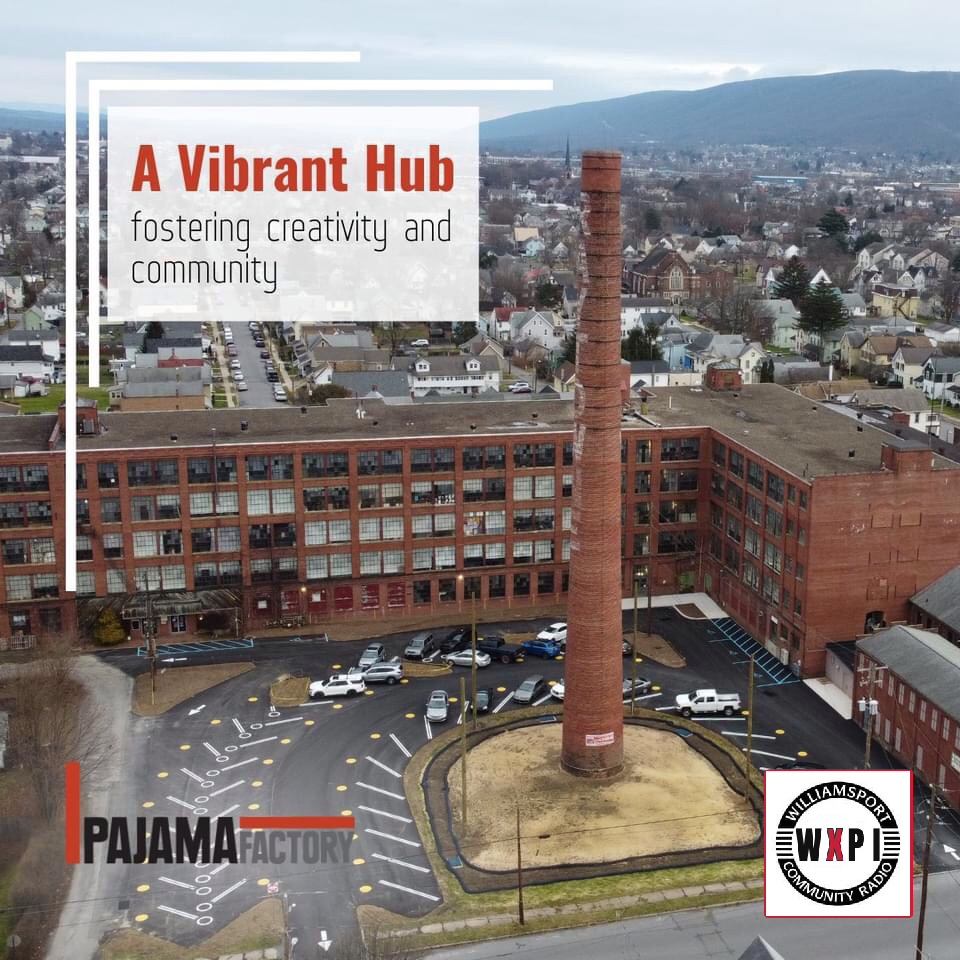
The pandemic almost shut down WXPI. Volunteers at the ten-year-old full-power station were pulled to other urgencies; and, for three years, the Williamsport, Pennsylvania, station ran almost exclusively on auto DJ.
Then, in November, 2023, a small group of newly-engaged local volunteers, inspired by committed WXPI President Curtis Musheno, decided to save the station. They took quick action—applying for and winning an LPFM license, launching a diverse selection of local music programs, renewing affiliation with Pacifica, planning fundraising activities, all with the support of the wider community and particularly with the support of the entrepreneurs and artists who work out of Williamsport’s Pajama Factory, a 300,000 square foot historic industrial building turned community hub that the station calls home.
On March 5, I spoke with Station Manager/Program Director Michael Lundy, Chaos Coordinator Cita (pronounced “Cheeta”) Waltz, and Associate Manager Justin Mackenzie about the station’s revival.
This conversation has been condensed and edited for clarity.
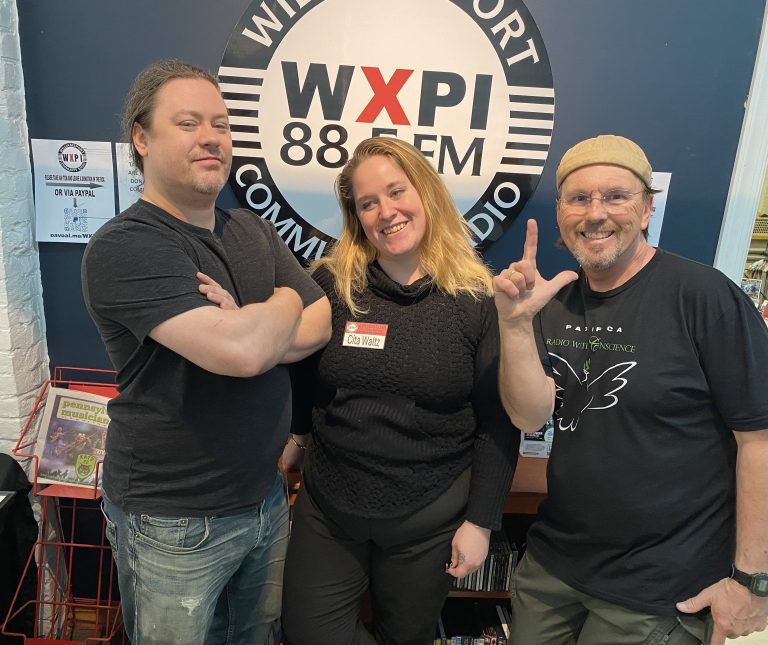
Diane: Hi everyone. Thank you for doing this and thank you for your work. I’m eager to hear about the station.
Michael: Before we start, we certainly appreciate everything Pacifica does but also [thank you for] getting the word out on what we’re doing here.
Diane: And that is really the point, to introduce you to the network as you start to work with everyone and share programming. So, why don’t we start with the story of the station.
Michael: Well, I’ll start, but Cita may want to step in because I’ve only been with the station about a year and a half.
The station began in 2010 as Williamsport Independent Media. They ran a local independent newspaper in the area; and, in 2010, they decided to begin a community radio station. They were granted an FCC license in 2011 and began broadcasting soon after on 88.5 FM. And, from what I understand—I was not in the area at the time, I was still in the military,–the station was very vibrant, very involved in the community. And the photographs I’ve seen attest to that vibrancy.
Fast forward to 2020 and COVID hits and most of the volunteers departed, partly due to COVID and then other life issues. And so, from about 2020 through 2023, the station was kind of on a hiatus. The program we ran with was auto DJ. We had [only] three on-air personalities [Steve Mendez, “Cowboy G,” and Bill Smedley] during that time. But the President of the Board of Directors [Curtis Musheno], through his efforts and his own money, kept the station running. [Then,] around November of 2023, a number of us got together. This was nothing planned. We all just found ourselves at this coffee shop. And the conversation began to move towards the radio station, and what we wanted to do with a radio station, and everyone was in agreement that the radio station WXPI is too important of a resource in the community to let die, for lack of a better term. So, at about that time, the last FCC low-power FM application window opened, and we accelerated and put that process into motion to submit an application for a construction permit for an LPFM license for another frequency.
And we were granted that construction permit as a singleton.
Diane: And, just to clarify for readers, if your LPFM application is a singleton that means that it is not in competition with other applicants. So, the FCC most likely [then] designated your application as Accepted for Filing.
Michael: Yes, that is where we’re at now. We are still broadcasting on 88.5 FM. But we are in the process of moving our antenna to be co-located with our studio and moving to a new frequency that we hope to have up and running by early summer. As with most community radio stations, we need money to do that. So we’re working on fundraising, and we are also working on ways to leverage some finances to make that happen.
Diane: We don’t often hear of full-power stations becoming LPFM stations. I’m guessing finances may have played a part.
Cita: So, [we initiated a] Make the Tower Louder program about three to four years ago when we realized that our antenna and equipment for the original full-power FM was starting to degrade and we were losing distance in broadcasting power as it was aging. We realized we had to upgrade our equipment; [but] we never actually got quite enough financial backing to make those big repairs, which is why we ended up moving into the option of LPFM and getting that construction permit. Now we’re mostly just focusing in on that.
Diane: I’m interested in hearing from each of you about your backgrounds, about how you got involved with the station and your current roles.
Michael: Well, I will start. I grew up in the Williamsport area. I spent 32 years in the United States Air Force and retired in 2012. When I was a teenager, 10, 11 years old, I used to pretend to be a DJ, used to get a little portable record player out, go into our rec room with a broomstick and a bunch of 45’s and pretend to be a DJ. But then life happens, and I spent 32 years in the Air Force, retired in 2012.
Then, about a year and a half ago, I began to put together a songwriter showcase here in the area, and I was looking to publicize this showcase. Somebody said, ‘You know, there’s a community radio station in town,’ and I said, ‘No, I don’t.’ So I finally figured out where they were located and there was nobody [there]. This was 2022, so there was nobody in the studio. So, I sent them a message on Facebook and said, ‘Would you be interested in helping me promote this songwriters showcase?’ They never answered my question. But they sent me back a response saying, ‘Would you be interested in doing a local music radio show for their station?’ And I said, ‘Well I’ve never done radio [but] my wife says I have a face for radio.’ So, after a couple of meetings with Curt, I began doing a local music radio show called The Rec Room Radio Hour in tribute to sitting in the rec room in my house. I’ve been doing that for a year and a half. And, [in December,] when we began to talk about revitalizing and rebuilding the station, someone in a less salient moment asked me to become the General Manager. And I must have been punch drunk because I agreed to it. And also the Program Director, so, after years of not knowing the station existed, I am now the General Manager, Program Director, and the primary cheerleader for the station.
Diane: And Cita?
Cita: I am legally blind and also deaf. So I happen to have a lot of time and I am a chronic hobbyist. Curt was a personal friend of mine before getting involved with the radio. He’s also our Engineer. So, he was looking for more people to get involved. There was a grant writing workshop that came up about a year or two ago now. And he was like, ‘Hey, you have free time. I need people,’ and that’s kind of how I got drug into this. I wasn’t really aware of what I was getting involved in. Being that I am hearing impaired, I don’t usually listen to the radio. But, ever since, I’ve definitely become more involved, I do enjoy my time with the people here and helping people get done what they want to get done. A lot of people here are very passionate about their projects and their programs, and I enjoy working with them.
Diane: And your title is Coordinator?
Michael: Cita, do you want me to give your actual title? I think everybody needs a title and that comes from my background in the military, so Cita is our Chaos Coordinator. She brings order to chaos. Cita is probably one of the most organized, dedicated and meticulous persons that I’ve had the pleasure of working with. I’ve worked with a lot of meticulous and intelligent people in my career, and she makes things happen. I really don’t think a lot of what is happening now, the foundation that we’re building with the new station, would happen if we didn’t have Cita working behind the scenes. So I want to make sure that I sing her praises in a public forum, and she’s going to kill me after this and that’s okay.
Cita: Sharpening my nails!
Michael: And speaking of passionate and dedicated people, we’ve been joined by Justin Mackenzie, who’s, for lack of a better term, our Associate Manager and one of our on-air personalities. He’s been on board about four months now, so I’ll let him jump in at some point.
Justin does another local music radio show called The Unheard Music. It’s underground music. It’s essentially independent, hard, but local indie, local hard rock, local metal music, that he puts out on the air. And another dedicated person. If I call on Justin for any kind of help, he is there and gives 110%.
Diane: So before we go to programming, Justin, would you want to talk about your background and what brought you to the station?
Justin: I have been playing guitar for a bunch of different groups in town. I happen to be a janitor at the building where the radio station is located. And I crossed paths with our leader Michael Lundy here, and it’s as simple as that. He talked to me about putting together a show and I agreed. And that was about four months ago. It’s been pretty smooth sailing ever since.
Diane: So, moving to programming now, Justin, would you continue and talk about your program?.
Justin: So in Williamsport, there’s a lot of underground music. There’s [also] a huge blues scene. But if you’re not really in with blues music, it’s kind of hard to get a platform for your band. What I’m trying to do is give an avenue to those musicians who are almost disenfranchised by the blues establishment in Williamsport.
Diane: And can you tell us about some of them?
Justin: Oh, bands like The Unfortunatz, Bloss, and Cloud. I play them a lot. Bands such as Stinking Lizards and Strange Highways. I’m always adding to the roster. Right now we got about 30 or 40 artists from Pennsylvania that we’re broadcasting that don’t normally get air play just because of the nature of their sound.
Diane: And this is a weekly program?
Justin: Yes.
Diane: Thanks. And now whoever wants to jump in. Let’s talk about some of the other local programming.
Michael: Well, I’ll jump in with my show, The Rec Room Radio Hour. It’s probably a little tamer version of [Justin’s] show. My show is made up of local musicians, local singer-songwriters, local bands. I’m a musician as well and had been pretty well networked in with the local music community here. We play a number of local bands, including Cass and the Bailout Crew which is an original and cover band. Jeff Mamett who is a Nashville recording artist and who is in the local area, we feature him. My collection is probably about 55 to 60 different artists and it’s growing.
And the one thing about curating my show and Justin curating his is that we share artists. If I get somebody that’s maybe a little too heavy for my rotation, I’ll give it to Justin and he takes it and runs with it and vice versa. If he gets something that’s really not going to fit into his format, he’ll send it to me and we’ll include it in our format. So it may seem like a small thing, that little bit of cross pollination between two shows, but that’s something that I have really been wanting to do. And we’re doing it. We’re helping each other out and supporting each other.

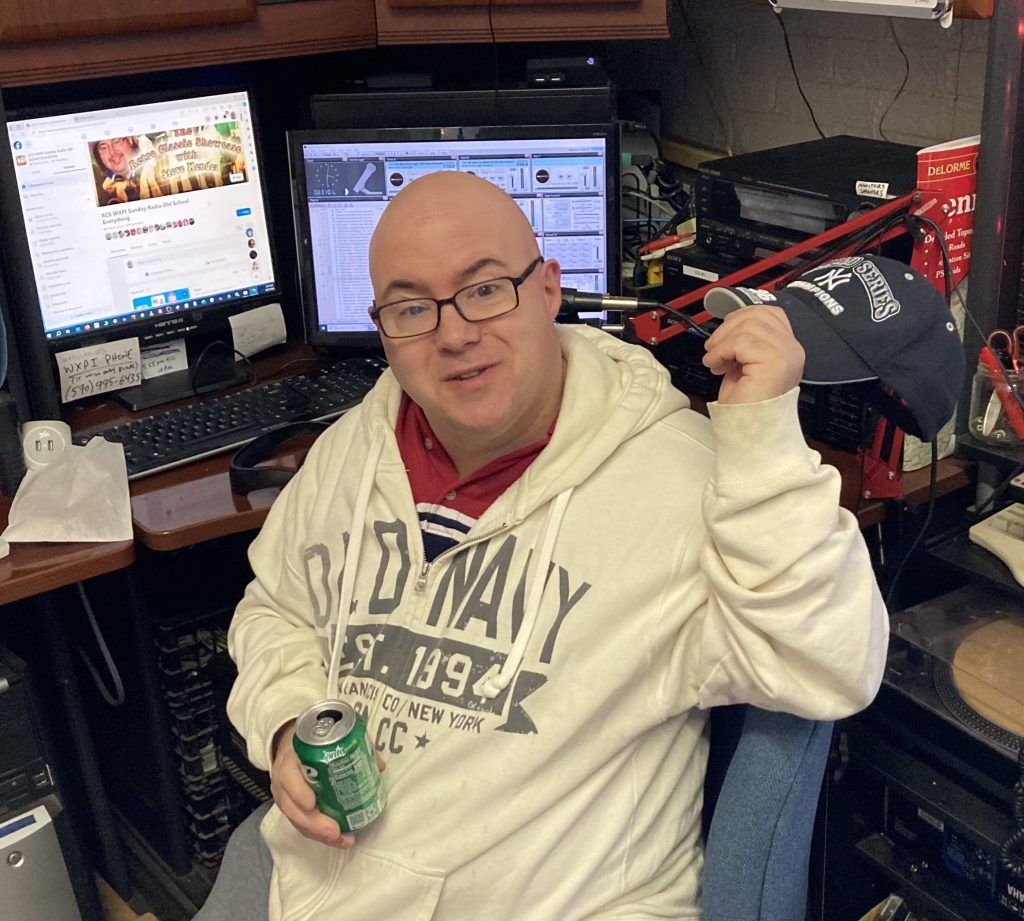
We also have Steve Mendez who curates his collection. His collection reaches into the 1000s. He curates a kind of old school classic R&B/disco/classic rock show, and he runs [The Retro Classic Showcase] every Sunday, seven straight hours on the air. He has a following across the country. When he’s on, his listener numbers are astronomically high. And he actively follows the social media stream during his show and takes requests. It’s really incredible to watch that show and to listen to it as well. And he plays some obscure stuff. I tried to stump him when I first came on board and I couldn’t. He has just about every classic R&B song that you can imagine.
We also have Cowboy G, the masked man of classic country music. He does a show [The Cowboy G Show] and he has a following, nationwide. A number of his followers are regular contributors to the station financially. And, lastly, we have Bill Smedley who has a globally syndicated old time music show [The Old Time Music Hour] that he curates. He not only collects artists from around the country, but he also does field recordings at different bluegrass and folk festivals. And his show is not only on WXPI but also on stations in Virginia, Scotland, upstate New York. It’s just incredible.
We also just began a show of ballroom dancing music. (Background laughter). Now wait a minute; it actually works. Through Cita’s and my efforts doing outreach to the service clubs in the area, we met Tom Inman. Tom teaches ballroom dancing with his wife, [so, he asked,] ‘Would you be interested in having a ballroom dancing show?’ ‘Well, certainly.’ I think within three weeks he had his pilot episode sent to us, and it’s called the Fabulous Virtual Ballroom hosted by Tom Inman. His first show was last week. The second show will be on this week, and we have a Facebook challenge for anyone that listens and dances to the music of the show. They’re to film it with their phones, and then hashtag the radio station, so that we can get them out there with their moves. The show is everything, from waltzes to foxtrots to Latin music. It’s crazy.
Lastly, we have Tru2daCore, a local hip hop/community involvement/community news show hosted by Don Bellinger. Don brings in a number of people from the community from the well-known to the unknown, interviews them, plays classic and up-to-date national and local hip hop, but he [also] gets the word out on what’s going on in the community. And we are going to build on that show to kind of embrace the local community here in Williamsport, with outreach and involvement.
Diane: I actually do want next to talk about community, but there is one more program I’d like to hear about. Your website mentions a program called News You Can Use.
Cita: John [Kiernan] has been doing a program on that for I don’t know how long. That’s just his thing. He’s been running it and running it and running it.
Michael: John does this completely from home and uploads the show virtually to the station every day. Every single day he puts out a synopsis of local news curated from the local newspapers, from a couple of independent news sources here in the area. Every single day. He’s been doing it for a while, since I’ve been here, but it’s been years. And again, that’s the beauty of this, that people are doing this. We’re all volunteers, of course, but they’re doing this because they have the passion to do it. And it’s just incredible to me, how much we have and how much we are able to build on that.
Diane: That is great. And you’ve nicely set up the next topic. Let’s create a picture of the local community. Who are your listeners? How do they influence your programming? How do they get involved in your programming?
Michael: Sure. Williamsport, Pennsylvania is the county seat of Lycoming County. It sits almost dead center in the state of Pennsylvania. Williamsport has a history of large industry. Back at the turn of the 19th into the 20th century, Williamsport was one of the lumber capitals of the nation, if not the world, to the point that they completely decimated the local hills of trees. There were more millionaires per capita in Williamsport at that time than anywhere else in the country. And we still have a stretch of road in Williamsport called Millionaire’s Row and the local high school is The Millionaires. [In] Williamsport, like most towns in the Northeast, the industry has almost left, but a number of big industries, the Shop-Vac Corporation (the industrial vacuum cleaner), are located here. And West Pharmaceuticals has two large facilities in the area. So we still have a good industrial base. We have two large medical centers. And, as Justin was alluding to, there’s a vibrant arts community in this area, musicians [that] include the blues, that include indie singer-songwriters. And also, we have a number of world class restaurants. We have at least five nationally known craft breweries in the area. We have a number of really good wineries in the area. There’s a lot going on in Williamsport both good and bad. Our listeners are growing. What I envision our listeners to be is anyone within the Williamsport area that wants to celebrate the local area, whether it’s art, news, music, dining, focus a mirror on the community and say, ‘Hey, here’s some things that we as a community can affect and change.’ And so that’s where I envision the station going in the long run, working, of course, with our Board of Directors.
Diane: Cita, would you want to say anything about the community?
Cita: The community is the reason that we’re here. That’s the only reason that I’m here, the only reason I’m involved, because of the passion specifically from Curtis Musheno and his exact need to fulfill this gap in the community. Williamsport [is a] vibrant place. We have people that are so different. If you go to New York, you get a good melting pot of human society, but we have that here in a concentrated form because we are so much smaller. We have just as much consistently dynamic humans. And we want to express that on the radio. We want to be able to have the blues; we want the underground; we want the rap. We want the hip hop; we want classic country. We want all of these things to be expressed in the community but also available to the community through the radio itself. Curt and his passion for this is really what got me involved in the first place, why I care to be involved and continue to serve the community itself.
Diane: So let’s follow that. Could both of you talk then a bit about how you find your volunteers, how you work with volunteers.
Michael: Well, usually I’ll set a trap outside our studio. Sometimes I’ll use like a cheese sandwich or maybe a Danish, and I’ll catch them. That’s pretty much how we got Justin. It really is. Our studio is located in a facility called the Pajama Factory, one of the old industries from Williamsport, probably started in the 30’s and reached its peak in the 50’s. They literally made pajamas and textiles. It is a huge brick building with a huge smokestack. A fellow by the name of Mark Winkelman purchased the building probably 12 to 14 years ago. Our studio is located here. The building is a small business and arts Incubator. We have everything in this building from not only our radio station but also a local coffee shop that roasts their own coffee on premises, a bicycle refurbishing, resale and hobbyist location, art studios.,,
Cita: …a wood-working shop, community garden, wrestling matches, ju-jitsu. We have the Clerestory Ballroom. If you can think of it, it might be going on here.
Michael: Yeah, as Cita alluded to, Saturday I was in the studio while Don Bollinger was doing his Tru2daCore show. And there was this cacophony of crowd noise. They were having mixed martial arts on the second floor above our studio. The place was packed. So, I think that’s a microcosm of why we are here doing this. There is just so much to be had in this area from arts and community sources that need to be showcased. And we are proud to showcase them now.
Diane: How big is this building?
Justin: Oh there’s multiple floors, there’s four floors with a total of 300,000 square feet and 5 interconnected buildings. There’s over a half mile of hallways that are used as art galleries. So, for the over 100 tenants here that are artists and entrepreneurs, the hallways serve as a gallery for everybody to showcase their work. There’s at least nine different buildings that make up the entirety of the compound. There are always parts of the building that are being developed. Some areas of the building aren’t developed yet, so we have an awesome maintenance crew, keeping things up to code and renovating the place for more businesses and artists and for WXPI.
Michael: Let me put the cherry on top of this sundae. We have been granted our construction permit for an LPFM for a new frequency. Our antenna will be on top of the [Pajama Factory] smokestack which is about 185 feet above actual terrain. It’s a big smokestack. If that’s not cool, I don’t know what is.
WXPI Strikes Up Some Spring Fundraiser Fun
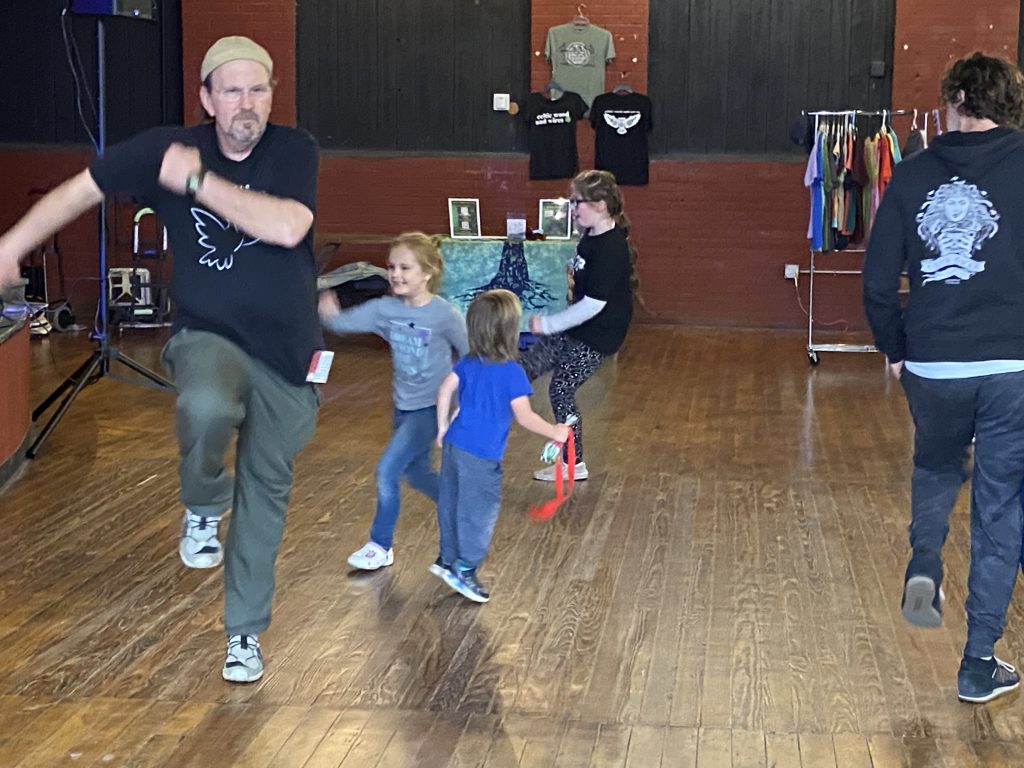

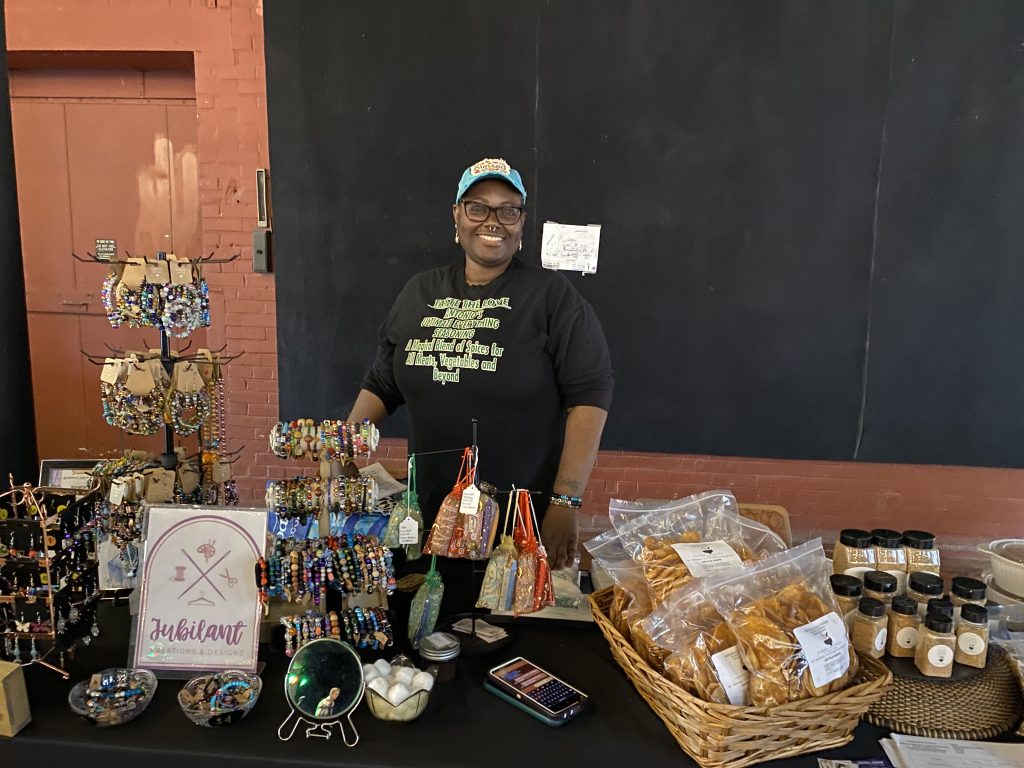
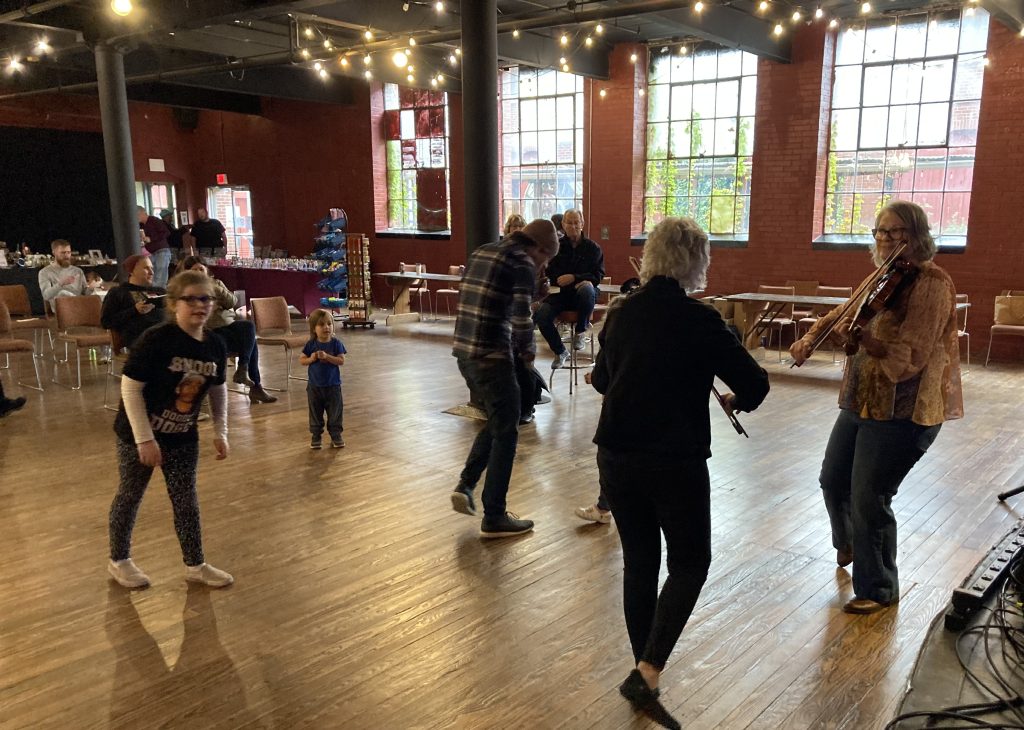
Diane: That’s such a good setup for a community to have so many organizations together. Michael, you mentioned in one of your emails that there were projects afoot for the station that you wanted to share. I don’t know if we’ve touched on those or if there is more to talk about that’s next for the station..
Michael: Well, the biggest thing is our construction permit for our LPFM at our new frequency, and the biggest project we have looming before us is getting that antenna on top of the smokestack. We, as every community radio station in the country is well aware, need folding American money to do that. And we’re having a huge fundraising event on the 27th of April. The leadership of the Pajama Factory have graciously allowed us to not so much piggy back but take over their annual event called The Pajama Factory Unbuttoned, which is an open house for the hundreds of tenants and artists here. They have graciously allowed us to make [that event] a fundraiser for us.
We have four local bands playing. We have four independent singer-songwriters performing. We are going to have food trucks, vendor tables, donated baskets to be raffled off. That’s kind of our big thing coming up.
Some of the smaller things that are part of the rebuilding is getting volunteers. We have a young lady who is our roving reporter in the area. Her name is Sarah Long. And last night she did an interview with a local band that will be featured on my radio show tonight. She’s also interviewed another local band that will be included in the local newspaper with references to the radio station. We have a number of other people that are going to be coming in for interviews, to chat and develop more ideas on local shows.
And, as you know, Justin’s on board. And I think the biggest thing that we’ve got going is that we have people like Justin taking the baton and running with it. I don’t have to worry about what Justin’s doing. I have the utmost respect for Justin. But Justin is the first of many coming on board that have a passion for telling a story for the community. So when I think where we’re going, I look at Justin Mackenzie and what he’s doing, and that’s where we’re going with the station as well.
And just to add a little bit more. We have regained our affiliation with Pacifica, and we are so happy about that. We are so happy to be able to leverage the content available from Pacifica here in the local areas. Cita had mentioned there are voices in this community that need to be heard. And the programming that we get from Pacifica fills our daytime content with views and opinions that deserve to be heard but are not normally heard on commercial, conventional radio here in this area. I am proud to say that our programming from Pacifica begins at 7AM and ends at 5PM every day, and I am proud to put our programming up against any other radio station in large part due to Pacifica but also to the local content that we have.
Diane: Thank you. That’s rewarding to hear. And it’s great to have someone that embodies the future.
Regarding Pacifica, you mentioned that the station regained its affiliation. So, WXPI was affiliated with Pacifica before the pandemic hiatus?
Michael: Station legacy had an affiliation with Pacifica. During the hiatus, our affiliation lapsed. One of the first things I did when they asked me to be the General Manager and Program Director [was to] reach out to Ursula about regaining our affiliation, and I couldn’t have asked for a better process. Everybody at Pacifica was like, ‘Oh yes. Welcome back. Let’s go.’ Again, we are lacking in folding American money here. They were so gracious in helping us prorate our initial cost. And immediately we began to leverage the Pacifica content in with what we’re doing now. So it’s good to be back.
Diane: That’s great. We’re happy to have you back. I did see that you have a full list of Pacifica offerings on your schedule.
There’s something I’d like to go back to before we finish up. You’ve both referenced the importance of Curtis Musheno and we haven’t really talked directly about him or his role at the station.
Cita: Curt is our President. He is on our Board of Directors. He is our Engineer. He is our programmer. He was literally the sole reason that the radio station survived the pandemic.
Diane: And he is still active with the station?
Cita: Yes, he is going to be meeting with us later today to discuss everything going on from today’s interview with you and other matters that we have at the station. I don’t see Curt going anywhere. We’re going to have to restrain him and throw him in a closet.
Michael: [A bit more about Curt] before we move on….[As we mentioned,] the origins of WXPI trace back to the Williamsport Guardian newspaper, an independent newspaper here in the area. Curt was their tech guy, their webmaster….[So,] Curt was not only instrumental in [founding the station]; he was [our original] station engineer and developed the website and [did all] the technical stuff….Curt’s a graduate of the Art Institute of Pittsburgh and he’s an artist when it comes to coding and site designing.
Curt does not like public recognition, but the heck with it. I cannot emphasize enough that he single-handedly kept the station going for the hiatus time during the pandemic. If it were not for Curtis Musheno, we would not be sitting here today. I’ve met a few people in my life and across my career in the 62 years I’ve been on this planet that I really admire. And Curtis is one of them. He and I [have disagreed] a few times on issues. But we are in lockstep [as to] where he and I want to take this station, and I could not be happier or prouder to call Curt not only the President of the station and the nonprofit that oversees the station, but to call him my friend. He is a gem of a person and he does not like public recognition. But he’s going to get some here.
Diane: And, Cita, you’ve said he is the person who brought you into the station.
Cita: That is correct. I was looking at the grant writing workshop to try and get funding for some projects that we were working on. And that’s how Michael and I met. So between the two of us going into that, I started getting a little bit involved. And then, over the next six months or so, getting more and more and more involved in this. And about that time Michael here became the General Manager and I became the Chaos Coordinator and now we’re actually making some good progress. I feel like the three of us are really working together as an executive team, and we have a ton of other humans getting things going, and hopefully it’ll broaden out a little more and there’ll be less work for the three of us and more work for all of us.
Diane: So, now, the last question always is to ask if there are important stories that I’ve missed. Are there things to be said about the station that I haven’t asked about?
Cita: So, our previous Board Members and those people who were [originally] involved are very important to us. Alison Hirsch had the brainchild for the radio station. She was the [first] General Manager of the station and essentially the founder. There’s no way we would have gotten any of this done without Alison. We have a bunch of stuff here in the office still, all of the times that we were in the newspapers or at this event or that event; and most of those things have her name all over them.
Michael: We stand on her shoulders as we move forward. [And, while she] now lives in Florida, we would like to have her involved in some way with bringing the station back to life because of her legacy and her hard work getting the station up.
[And] Barbara Andreassen who designed the logo for the station that we’re going to keep using with the new frequency. She was instrumental in building the programming in the early days.
Cita: Bob Herzenberg, our original business manager [who passed away in 2019] and John Kiernan, [who is] essentially [still] the news director. He’s been on the Board since the beginning. Our legacy is very important to us. There are so many people who have been here throughout the years that have done amazing things to help us get where we are now.
All photos used with permission of General Manager Michael Lundy of WXPI in Williamsport, PA.

